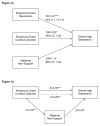Trajectories of preschool disorders to full DSM depression at school age and early adolescence: continuity of preschool depression
- PMID: 24700355
- PMCID: PMC4103647
- DOI: 10.1176/appi.ajp.2014.13091198
Trajectories of preschool disorders to full DSM depression at school age and early adolescence: continuity of preschool depression
Abstract
Objective: Preschool-onset depression, a developmentally adapted form of depression arising between ages 3 and 6, has demonstrated numerous validated features, including characteristic alterations in stress reactivity and brain function. This syndrome is characterized by subthreshold DSM criteria for major depressive disorder, raising questions about its clinical significance. To clarify the utility and public health significance of the preschool-onset depression construct, the authors investigated diagnostic outcomes of preschool children at school age and in adolescence.
Method: In a longitudinal prospective study of preschool children, the authors assessed the likelihood of meeting full criteria for major depressive disorder at age 6 or later as a function of preschool depression, other preschool axis I disorders, maternal history of depression, nonsupportive parenting, and traumatic life events.
Results: Preschool-onset depression emerged as a robust predictor of major depressive disorder in later childhood even after accounting for the effect of maternal history of depression and other risk factors. Preschool-onset conduct disorder also predicted major depression in later childhood, but this association was partially mediated by nonsupportive parenting, reducing by 21% the effect of preschool conduct disorder in predicting major depression.
Conclusions: Study findings provide evidence that this preschool depressive syndrome is a robust risk factor for developing full criteria for major depression in later childhood, over and above other established risk factors. The results suggest that attention to preschool depression and conduct disorder in addition to maternal history of depression and exposure to trauma may be important in identifying young children at highest risk for later major depression and applying early interventions.
Figures

Comment in
-
Preschool-onset depression predicts major depressive disorder and other psychiatric disorders in later childhood and early adolescence.Evid Based Ment Health. 2015 May;18(2):47. doi: 10.1136/eb-2014-101974. Epub 2015 Jan 21. Evid Based Ment Health. 2015. PMID: 25609589 Free PMC article. No abstract available.
Similar articles
-
Maternal depression and early positive parenting predict future conduct problems in young children with attention-deficit/hyperactivity disorder.Dev Psychol. 2007 Jan;43(1):70-82. doi: 10.1037/0012-1649.43.1.70. Dev Psychol. 2007. PMID: 17201509
-
Moderators and mediators of a maternal depression treatment study: Impact of maternal trauma and parenting on child outcomes.Compr Psychiatry. 2018 Oct;86:123-130. doi: 10.1016/j.comppsych.2018.08.001. Epub 2018 Aug 3. Compr Psychiatry. 2018. PMID: 30118995 Free PMC article.
-
The caregiving environments provided to children by depressed mothers with or without an antisocial history.Am J Psychiatry. 2006 Jun;163(6):1009-18. doi: 10.1176/ajp.2006.163.6.1009. Am J Psychiatry. 2006. PMID: 16741201
-
[Posttraumatic stress disorder (PTSD) as a consequence of the interaction between an individual genetic susceptibility, a traumatogenic event and a social context].Encephale. 2012 Oct;38(5):373-80. doi: 10.1016/j.encep.2011.12.003. Epub 2012 Jan 24. Encephale. 2012. PMID: 23062450 Review. French.
-
Childhood depressive disorders.Dan Med J. 2016 Oct;63(10):B5290. Dan Med J. 2016. PMID: 27697136 Review.
Cited by
-
Excitability and irritability in preschoolers predicts later psychopathology: The importance of positive and negative emotion dysregulation.Dev Psychopathol. 2019 Aug;31(3):1067-1083. doi: 10.1017/S0954579419000609. Epub 2019 May 21. Dev Psychopathol. 2019. PMID: 31109387 Free PMC article.
-
Risk factors for developmental vulnerability: Insight from population-level surveillance using the Early Development Instrument.Digit Health. 2023 Nov 3;9:20552076231210705. doi: 10.1177/20552076231210705. eCollection 2023 Jan-Dec. Digit Health. 2023. PMID: 37928328 Free PMC article. Review.
-
The longitudinal association between potential stressful life events and the risk of psychosocial problems in 3-year-old children.Front Public Health. 2023 Mar 21;11:1100261. doi: 10.3389/fpubh.2023.1100261. eCollection 2023. Front Public Health. 2023. PMID: 37026130 Free PMC article.
-
Mapping the Frequency and Severity of Depressive Behaviors in Preschool-Aged Children.Child Psychiatry Hum Dev. 2017 Dec;48(6):934-943. doi: 10.1007/s10578-017-0715-2. Child Psychiatry Hum Dev. 2017. PMID: 28281019 Free PMC article.
-
No associations in preregistered study of youth depression and functional connectivity of fronto-parietal and default mode networks.Neuroimage Rep. 2021 Sep;1(3):100036. doi: 10.1016/j.ynirp.2021.100036. Epub 2021 Jul 17. Neuroimage Rep. 2021. PMID: 37207026 Free PMC article.
References
-
- Luby JL, Heffelfinger A, Mrakotsky C, Brown K, Hessler M, Wallis J, Spitznagel E. The clinical picture of depression in preschool children. J Am Acad Child Adolesc Psychiatry. 2003;42:340–8. - PubMed
-
- Egger H, Angold A. Common emotional and behavioral disorders in preschool children: Presentation, nosology, and epidemiology. J Child Psychol Psychiatry. 2006;47:313–37. - PubMed
-
- Luby JL, Heffelfinger A, Mrakotsky C, Brown K, Hessler M, Spitznagel E. Alterations in stress cortisol reactivity in depressed preschoolers relative to psychiatric and no-disorder comparison groups. Arch Gen Psychiatry. 2003;60:1248–55. - PubMed
Publication types
MeSH terms
Grants and funding
LinkOut - more resources
Full Text Sources
Other Literature Sources

